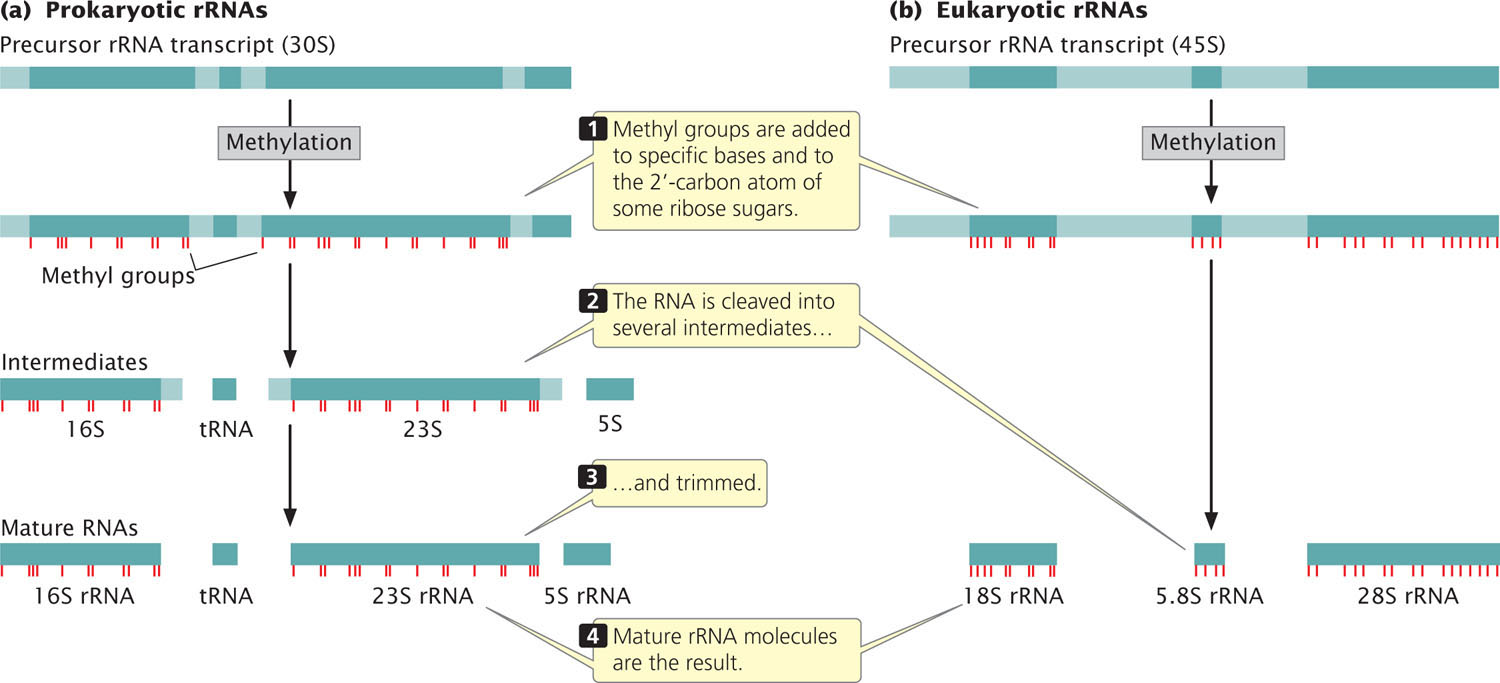14.4 Ribosomal RNA, a Component of the Ribosome, Is Also Processed after Transcription
Within ribosomes, the genetic instructions contained in mRNA are translated into the amino acid sequences of polypeptides. Thus, ribosomes play an integral part in the transfer of genetic information from genotype to phenotype. We will examine the role of ribosomes in the process of translation in Chapter 15. Here, we consider ribosome structure and examine how ribosomes are processed before becoming functional.
The Structure of the Ribosome
The ribosome is one of the most abundant molecular complexes in the cell: a single bacterial cell may contain as many as 20,000 ribosomes, and eukaryotic cells possess even more. Ribosomes typically contain about 80% of the total cellular RNA. They are complex structures, each consisting of more than 50 different proteins and RNA molecules (Table 14.3). A functional ribosome consists of two subunits, a large ribosomal subunit and a small ribosomal subunit, each of which consists of one or more pieces of RNA and a number of proteins. The sizes of the ribosomes and their RNA components are given in Svedberg (S) units (a measure of how rapidly an object sediments in a centrifugal field). It is important to note that S units are not additive; combining a 10S structure and a 20S structure does not necessarily produce a 30S structure, because the sedimentation rate is affected by the three-dimensional structure as well as the mass. The three-dimensional structure of the bacterial ribosome has been elucidated in great detail through X-ray crystallography. More will be said about the ribosome’s structure in Chapter 15.
| Cell Type | Ribosome Size | Subunit | rRNA Component | Proteins |
|---|---|---|---|---|
| Bacterial | 70S | Large (50S) | 23S (2900 nucleotides), 5S (120 nucleotides) | 31 |
| Small (30S) | 16S (1500 nucleotides) | 21 | ||
| Eukaryotic | 80S | Large (60S) | 28S (4700 nucleotides), 5.8S (160 nucleotides), 5S (120 nucleotides) | 49 |
| Small (40S) | 18S (1900 nucleotides) | 33 | ||
| Note: The letter “S” stands for “Svedberg unit.” | ||||
401
Ribosomal RNA Gene Structure and Processing
The genes for rRNA, like those for tRNA, can be present in multiple copies, and the numbers vary among species (Table 14.4); all copies of the rRNA gene in a species are identical or nearly identical. In bacteria, rRNA genes are dispersed, but in eukaryotic cells they are clustered, with the genes arrayed in tandem, one after another.
| Species | Number of Copies of rRNA Genes per Genome |
|---|---|
| Escherichia coli | 7 |
| Yeast | 100–200 |
| Human | 280 |
| Frog | 450 |
Eukaryotic cells possess two types of rRNA genes: a large gene that encodes 18S rRNA, 28S rRNA, and 5.8S rRNA, and a small gene that encodes the 5S rRNA. All three bacterial rRNAs (23S rRNA, 16S rRNA, and 5S rRNA) are encoded by a single type of gene.
Ribosomal RNA is processed in both bacterial and eukaryotic cells. In E. coli, each RNA gene is transcribed into a 30S rRNA precursor (Figure 14.21a). This 30S precursor is methylated in several places, and then cleaved and trimmed to produce 16S rRNA, 23S rRNA, and 5S rRNA, along with one or more tRNAs. A series of enzymes bring about cleavage, methylation, and trimming.

Eukaryotic rRNAs undergo similar processing (Figure 14.21b). Small nucleolar RNAs (snoRNAs) help to cleave and modify eukaryotic rRNAs and assemble the processed rRNAs into mature ribosomes. Like the snRNAs taking part in pre-mRNA splicing, snoRNAs associate with proteins to form ribonucleoprotein particles (snoRNPs). The snoRNAs have extensive complementarity to the rRNA sequences in which modification takes place. Interestingly, some snoRNAs are encoded by sequences in the introns of other protein-encoding genes. The processing of rRNA and ribosome assembly in eukaryotes take place in the nucleolus.
CONCEPTS
A ribosome is a complex organelle consisting of several rRNA molecules and many proteins. Each functional ribosome consists of a large and a small subunit. Ribosomal RNAs in both bacterial and eukaryotic cells are modified after transcription. In eukaryotes, rRNA processing is carried out by small nucleolar RNAs.
 CONCEPT CHECK 8
CONCEPT CHECK 8
What types of changes take place in rRNA processing?
- Methylation of bases
- Cleavage of a larger precursor
- Nucleotides are trimmed from the ends of rRNAs.
- All of the above
402